Operational Models
The CALP Network’s State of the World’s Cash Report identifies different types of operational model, including consortia and alliances, shared cash delivery mechanisms, single agency cash delivery, and integration of systems.
“The overall structure through which agencies work jointly…to deliver cash and voucher programming…in situation response and analysis, program design and implementation.”
Our working definition of an operational model.
Scaling up CVA offers opportunities to transform how humanitarian aid is delivered. It has implications for the roles of different agencies within various operational models, and the potential for models to link to social protection systems. It will also impact the nature of partnerships with financial service and technology providers, and how different models interact with other forms of assistance, beyond cash.
Current priorities
Since late 2016, the CALP Network has been coordinating a learning agenda to help answer these questions:
- What operational models are available to agencies implementing CVA?
- How do different models improve the efficiency, effectiveness and accountability of CVA in different contexts?
- Which operational models are most appropriate in which contexts?
We will continue to collate and disseminate the evidence base for operational models.
We are also a partner in the Cash Monitoring, Evaluation, Accountability, and Learning Organizational Network (CAMEALEON) consortium, led by Norwegian Refugee Council, which is responsible for independent monitoring and evaluation of WFP’s Multi-Purpose Cash Assistance (MPCA) in Lebanon. This includes research and analysis regarding value for money and accountability in the operational model.
Featured content

Operational Models: Accountability to affected people
Webinar

MEAL in Emerging Operational Models
Webinar

CTP Operational Models Analytical Framework
Guidelines and Tools
The State of the World’s Cash Report launched by the CALP Network in February 2018 highlights trends in the uptake of various operational models for the delivery of cash at scale in humanitarian response. Current decision making on the choice between these various operational models is highly influenced by context, and by the policies and approaches of donor agencies. Decision making on...
Thematic lead
Latest
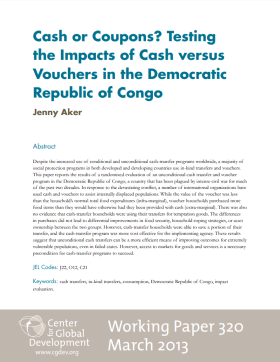
Cash or Coupons? Testing the impacts of cash transfers versus vouchers in the Democratic Republic of Congo
Report
Despite the increased use of conditional and unconditional cash-transfer programs worldwide, a majority of social protection programs in both developed and developing countries use in-kind transfers and vouchers. This paper reports the results of a randomized evaluation of an unconditional cash transfer...
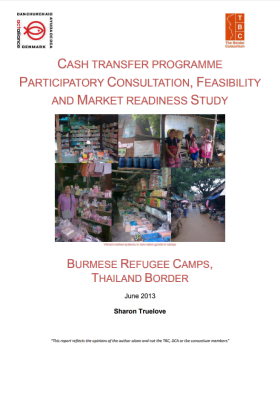
Cash Transfer Programme Participatory Consultation, Feasibility and Market Readiness Study: Burmese refugee camps, Thailand border
Report
This report is a participatory consultation, cash feasibility and market readiness study of the Burmese refugee camps on the Thailand border. It is a rapid, snap shot guide as to whether the conditions in two contrasting camps out of the full nine camps are conducive to a switch from the current ration...

Cash Emergency Preparedness (CEP) Pilots
Guidelines and Tools
CEP guidelines and Key findings from pilot assessments

Cash transfer programming in urban emergencies: a toolkit for practitioners
Guidelines and Tools
In recognition of the increasing urban populations around the world and their increasing vulnerability to disasters, the the CALP Network endeavored to investigate the current status and impact of urban emergency response programs that utilise cash transfer programming. This study aims to better...

Cash Transfer Programming in Urban Emergencies: Tools (Annex 2)
Guidelines and Tools
This file contains the following tools referenced as Annex 2 of the the CALP Network Urban Toolkit:
1. Sample Focus Group Discussion Questionnaire to Establish Urban-Specific Vulnerability Criteria
2. Sample Urban Household Survey
3. Template in PowerPoint of Commodity Market Map
4. Template in PowerPoint...
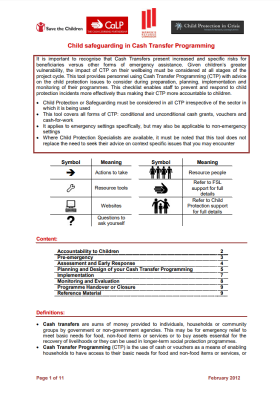
Child Safeguarding in Cash Transfer Programming Tool
Guidelines and Tools
It is important to recognise that Cash Transfers present increased and specific risks for beneficiaries versus other forms of emergency assistance. Given children’s greater vulnerability, the impact of CTP on their wellbeing must be considered at all stages of the project cycle. This tool provides...
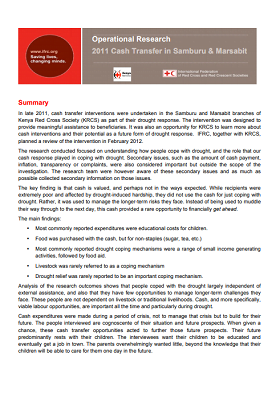
Operational Research: 2011 Cash Transfer in Samburu & Marsabit
Report
In late 2011, cash transfer interventions were undertaken in the Samburu and Marsabit branches of Kenya Red Cross Society (KRCS) as part of their drought response. The intervention was designed to provide meaningful assistance to beneficiaries. It was also an opportunity for KRCS to learn more about cash...

Market Information and Food Insecurity Response Analysis (MIFIRA) Framework Course
Guidelines and Tools
Access Course Here This course outlines the rationale for “response analysis” and introduces a field-tested, systematic approach to this emergent activity. The Market Information and Food Insecurity Response Analysis (MIFIRA) framework provides a logically sequenced set of questions that help...

Child Safeguarding in Cash Transfer Programming
Guidelines and Tools
While cash transfers have become a key intervention in emergencies, they also pose increased and additional risks for beneficiaries, compared with other forms of assistance. Children are particularly vulnerable, and even more so in emergencies. The impact of cash transfer programming on children’s...

Emergency Food Security and Livelihoods (EFSL) 48-hour Assessment Tool
Guidelines and Tools
The purpose of the 48-hour assessment tool is to obtain a quick understanding of the emergency food security and livelihood (EFSL) situation within the first few days after a rapid-onset disaster. Initially developed by Oxfam, this tool aims to support response teams to meet requirements in emergencies in...

Emergency Food Security and Livelihoods (EFSL) 48-hour Facilitator’s Materials
Guidelines and Tools
Developed by Oxfam and supporting ECB agencies, the EFSL training materials can be used to train participants to confidently apply the ‘48-hour assessment tool’ to assess the impact of a shock/hazard on an affected population’s food security and livelihoods. The Facilitator Materials include session...
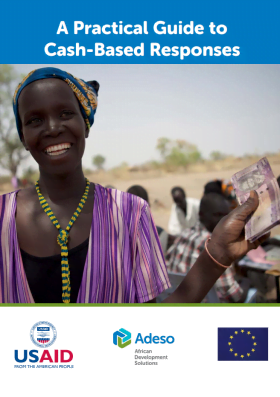
A Practical Guide to Cash-Based Response
Guidelines and Tools
A Practical Guide to Cash-based Responses is a manual developed by Adeso to share the organisation’s experience in developing and implementing appropriate cash-based responses. The manual highlights some practical problems that are faced by implementation teams around the world and it is intended to...

Cash Transfers in Nairobi’s Slums
Report
In Kenya, a combination of factors led to the food crisis of 2008–9, which put around 9.5 million people at risk of starvation. About 4.1 million of those affected were living in informal settlements (slums) in the capital, Nairobi. Oxfam and Concern Worldwide developed a joint programme to address...
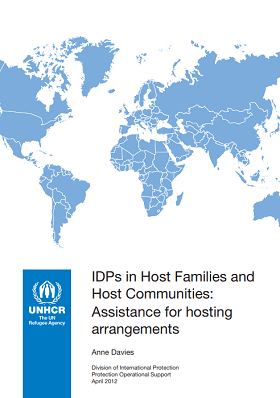
IDPs in Host Families and Host Communities: Assistance for Hosting Arrangements
Report
The phenomenon of internally displaced persons (IDPs) and refugees residing with host families is still relatively unexplored in comparison to what is known about IDPs and refugees living in camps. Of the nearly 14.7 million IDPs protected and assisted by UNHCR in 2010, an estimated 52% of the total live...

Impact Evaluation of Cash, Food Vouchers, and Food Transfers among Colombian Refugees and Poor Ecuadorians in Carchi and Sucumbíos
Report
This report is the final impact evaluation of the World Food Programme’s Food, Cash, and Voucher intervention and contains analysis on outcomes including food security, social capital, anemia, and gender issues. Due to the targeting of Colombian refuges and poor Ecuadorians in Northern Ecuador, it also...

Examining Differences in the Effectiveness and Impacts of Vouchers and Unconditional Cash Transfers
Report
The objective of this study is to examine the differences in the effectiveness and impacts of vouchers versus unconditional cash transfers in the Bushani camp of the Masisi territory of the Democratic Republic of Congo. As part of this research, the study team collected household data from over...
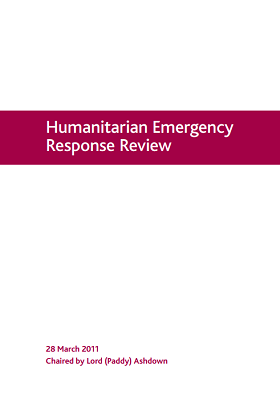
Humanitarian Emergency Response Review
Report
This independent review into how the UK (through DFID) responds to humanitarian emergencies, considers how the UK should best respond to overseas emergencies and the role the UK should play in the international humanitarian system. It looks at the potential future humanitarian challenges and the...

Oxfam Programme Quality Standards: Cash transfer programmes (CTPs)
Guidelines and Tools
Through its Emergency Food Security and Vulnerable Livelihoods (EFSVL) work, Oxfam aims to meet immediate food needs and protect livelihoods, whilst contributing to the longer term economic recovery of disaster affected populations and increasing their resilience to future shocks. Oxfam believes that...
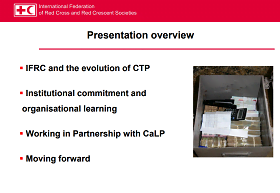
IFRC and the evolution of CTP
Presentation
An IFRC presentation covering the following topics: IFRC and the evolution of CTP Institutional commitment and organisational learning Working in Partnership with the CALP Network Moving forward
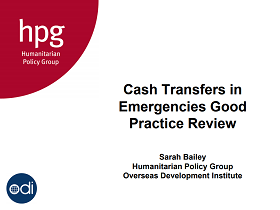
Cash Transfers in Emergencies Good Practice Review: Presentation
Presentation
Powerpoint presentation on the then-forthcoming Good Practice Review on cash transfer programming in emergencies.
